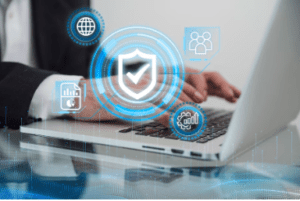Unlocking Industry Leadership With CMMC 2.0 Compliance
The Department of Defense (DoD), which mandated the Cybersecurity Maturity Model Certification (CMMC), has set certain cybersecurity standards for suppliers. CMMC 2.0 continues to streamline these standards.
It is also easy to comply with CMMC requirements while still having strong security practices.
Furthermore, as per the latest CMMC news posted in December 2024, CMMC officially became the DoD’s cybersecurity program, implying that CMMC cybersecurity is now a requirement if you want to handle a DoD contract as per the recently issued CMMC rule.
This rule is moving companies to the forefront of cybersecurity excellence and making them trusted industry leaders in a security-aware world.
To assist you in fully grasping its effects, we have compiled insights into how CMMC 2.0 influences businesses and stays one step ahead in the ever-evolving CMMC landscape.
CMMC 2.0 from a Technical Slant
The old CMMC framework has been broken down into 3 independent levels in accordance with trusted NIST (National Institute of Standards and Technology) standards. Here’s a quick rundown.
Level 1
- It is used to protect Federal Contract Information (FCI).
- This level implements basic safeguards according to select controls defined in NIST SP 800-171.
- Annual self-assessment is required at this level to ensure that security practices are continuously updated.
Level 2
- CMMC level 2 elevates security to safeguard Control Unclassified Information (CUI).
- All 110 security requirements mandated by NIST SP 800-171 should be implemented at this level.
- It requires critical programs to be assessed by third parties every three years.
Level 3
- This is designed to fight APTs.
- For the highly classified security measures, this level complies with NIST SP 800-172.
- This level of protection is maintained at its peak through government-led assessments.
It’s not just about meeting DoD requirements; it’s about laying a more substantial security foundation and ensuring your organization is always safe from evolving cyber-attacks.
Implementing CMMC 2.0
A structured approach is necessary to achieve CMMC 2.0 compliance. The steps to implement such compliance are outlined in detail below.
1. Conduct a Gap Analysis
At this step, you look at your current security practices and compare them to NIST SP 800-171 or 800-172 controls, depending on the level you require.
As a result, you’ll find a gap or a weakness you should focus on and prioritize. This process can be supplemented with automated tools that aid in visualizing your organization’s state and creating a clear plan of action that aligns with the set goals.
Accordingly, an organization can progress closer toward building a better way to enforce a better cybersecurity posture.
2. System Security Plan (SSP)

Essentially, the System Security Plan (SSP) is an integral document that shows how each layer of your system’s security is constructed. This plan involves all the material, like security policies, the defined roles, and how to implement and manage the security controls properly. Plus, modifying this plan with new updates to your organization is crucial to keeping up with all the evolving threats and changes.
That includes ensuring the SSP is easy to audit & assess for, giving you assurance you have a sound security posture.
3. Plan of Action and Milestones (POA&M)
Plan of Action and Milestones (POA&M) is a roadmap to cover the vulnerabilities discovered in the gap analysis. It presents a set of clear, actionable steps to rectify security gaps with focused deadlines to accomplish them.
Tracking progress and check-ins are also necessary to keep the plan on track and to ensure accountability. So, using this structured method, your organization stays on track to achieve complete CMMC 2.0 compliance.
4. Access Control Measures
Robust access control measures should be enforced to protect sensitive information. Therefore, role-based access control (RBAC) should be utilized to give permission to individuals based on their job functions. It simplifies access management and mitigates the risk of accidental or unauthorized access. This security measure matches the requirements of CMMC 2.0.
5. Multi-Factor Authentication (MFA)

A requirement to comply with CMMC 2.0 is enforcing MFA across all access points. That means multiple verifying channels are required to grant access. Therefore, it protects against unauthorized entry even if the credentials are compromised.
Further, its regular monitoring and auditing of authentication logs can detect suspicious activity. As a result, your organization can quickly respond to threats and build a reliable brand image that keeps cybersecurity at a very high level.
The Competitive Advantage: Industry Leadership Through Compliance
CMMC 2.0 compliance is more than just regulatory — it’s about positioning your organization as a security-driven industry leader. These security practices not only improve your company’s cybersecurity posture but offer a distinct competitive edge.
1. Enhancing Cyber Resilience
The CMMC 2.0 compliance builds reliable organization readiness to detect, respond to and recover from cyberattacks. So, if your business implements continuous monitoring of security issues, it will create a resilient infrastructure that adapts to newer threats.
2. Boosting Client Trust and Confidence
Trust is eroding instantly by data breaches.
CMMC 2.0 certification demonstrates that the organization prioritizes data protection. As a result, it shows to clients, partners, and stakeholders that your organization is trustworthy. So, your organization sounds like a good option for a business partnership.
3. Expanding Market Opportunities
If you can demonstrate compliance with CMMC, DoD contracts, and many partnerships with security-aware companies, you will want to work with you. That means once your organization meets CMMC standards, it becomes qualified for high-value projects. Hence, it increases your brand market value and gains a competitive edge.
4. Strengthening Supply Chain Security
The most exploited entry points for cyberattacks are supply chain vulnerabilities. For this reason, rigorous assessments are applied to third-party partners to verify they adhere to CMMC security requirements. In turn, it reduces risks and strengthens your entire supply chain.
5. Elevating Brand Reputation
A proactive stance on cybersecurity demonstrates that you have achieved compliance. So, if your organization has CMMC 2.0 certification in marketing materials and proposals, it is considered a leading security agency. It helps build your brand credibility.
6. Improves Operational Efficiency
The culture of continuous improvement is created in the process of aligning CMMC 2.0. In addition, internal processes are streamlined, documentation is improved, and communication is enhanced between departments, leading to operational efficiency.
7. Future-Proofing Against Regulatory Changes
Regulatory bodies are changing their requirements as cyber security threats evolve. On that note, CMMC 2.0 enables organizations to be prepared for future changes as they ensure continuing adaptation to accommodate various security disruptions.
Thus, any organization with CMMC 2.0 compliance can become the leading brand in the cybersecurity industry.
Overcoming CMMC Compliance Challenges with Practical Solutions
While CMMC 2.0 compliance can be difficult, strategic planning and the use of technology can facilitate this journey:
1. Resource Constraints
For numerous organizations, there are limited resources, which can make CMMC 2.0 compliance feel insurmountable. Plus, NIST SP 800-171 and 800-172 standards involve continuous monitoring and reporting that can be a burden to small IT teams.
Here, outsourcing key cybersecurity functions to MSSPs (Managed Security Service Providers) is one effective solution.
MSSP provides continuous monitoring, incident response and risk management without overburdening the internal teams. Also, partnering with third-party security assessors helps identify vulnerabilities and develop tailored strategies.
Therefore, it not only reduces the workload but also enables experienced professionals to guide compliance efforts, which overall improves security.
2. Knowledge Gaps

A major challenge to CMMC 2.0 compliance lies in a lack of cybersecurity knowledge among staff. Not all employees may know how to protect Controlled Unclassified Information (CUI) or what Advanced Persistent Threats (APTs) are. This gap should be bridged through organizations’ continuous training programs in cybersecurity.
These programs should focus on threat recognition, how to appropriately handle sensitive data or tips on password management and multi-factor authentication (MFA).
Hence, by encouraging a security-first mindset across all departments, you help build a culture of awareness and accountability in your organization.
3. Cost Concerns
For small and mid-sized businesses, the cost of compliance with CMMC 2.0 may be a problem to scale. Also, CMMC certification costs must be managed strategically.
For example, resources can be utilized effectively by prioritizing assessments for systems handling CUI and FCI. Plus, verify with research that your partners in the supply chain are also compliant, lowering risks.
Your organization should also perform accurate, cost-effective audits with certified assessors while incorporating automated tools to reduce data collection expenses.
Furthermore, use ready-made templates to make documentation easy and set clear deadlines to prevent long audits. Not only does this reduce cost, but it also helps fortify cybersecurity cultures, making CMMC compliance much smoother.
Aim for Cybersecurity Excellence and Business Growth with CMMC 2.0
CMMC 2.0 compliance drives the enhancement of cybersecurity practices and creates new business possibilities. Organizations that adopt this framework not only protect sensitive data but also position themselves as industry leaders.
Its compliance enhances cyber resilience, boosts client trust, expands market opportunities, strengthens supply chain security, elevates brand reputation, improves operation efficiency and future-proofs against regulatory changes.
These aforementioned benefits show the significance of CMMC 2.0 compliance in organizations.
So, incorporate CMMC 2.0 compliance now to make your organization as security-driven as never before against cyber threats.

Recent Comments